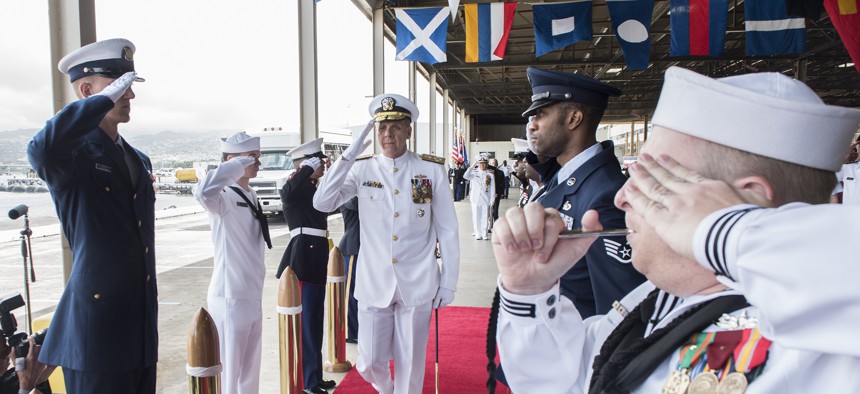
Adm. Phil Davidson, commander of the newly renamed U.S. Indo-Pacific Command, is piped aboard during the USPACOM change of command ceremony. Mass Communication Specialist 2nd Class James Mullen/U.S. Navy
Pentagon Rebrands PACOM as ‘Indo-Pacific Command’
The change is symbolic, defense officials say, but it emphasizes the U.S.’s commitment to new partnerships.
U.S. Pacific Command, the military’s largest geographical area command, has a new name: U.S. Indo-Pacific Command, Defense Secretary Jim Mattis said Wednesday. The change follows a year of Pentagon signals about stretching beyond East Asia and into the subcontinent, in part to better compete with China and Iran.
“In recognition of the increasing connectivity of the Indian and Pacific Oceans, today we rename the U.S. Pacific Command to U.S. Indo-Pacific Command,” Mattis said Wednesday at the command’s headquarters in Honolulu. “Over many decades, this command has repeatedly adapted to changing circumstances, and today that carries that legacy forward as America focuses west.”
For weeks, Mattis had occasionally referred to the Far East as the “Indo-Pacific” region. Speculation about the name change heated up a week ago when one reporter publicly inquired about it at the Pentagon. Mattis made it official at the change-of-command ceremony in which Adm. Harry Harris turned PACOM over to Adm. Phil Davidson.
Under the U.S. military’s scheme for dividing the globe into six geographic combatant commands, India was already part of Pacific Command. No personnel or assets are being moved as part of the change.
"The re-branding is about recognizing the reality of India’s rise and role in regional and global security,” a senior defense official told reporters traveling with Mattis. “In addition, it recognizes the reality that in order to provide security in the region it’s necessary to acknowledge and capture the connectivity between the Pacific and Indian Oceans. The U.S. wants to work with India to help it expand its relationships in the region.”
At press time, Pentagon officials had not announced the command’s new informal military acronym-style name, though one official said it would likely be along the lines of INDO-PACOM.
The U.S. has been rethinking the Pacific-Indian Ocean linkage since at least 2011, when President Barack Obama announced a “pivot to the Pacific.” The shift was later criticized as lacking conviction and heft, especially as U.S. involvement in Middle East conflicts lingered.
Under Trump’s administration, the Pentagon has prioritized a stronger relationship with India, but it has come amid a stated return to great-power competition — and of course, the U.S. involvement in conflicts in Afghanistan, the Middle East, and Africa.
Related: Take Small Steps to Advance the US-India Relationship
Related: Hagel Begins Asian Pivot as the Middle East Burns
Related: Pentagon Pivots Within the Pivot, to Southeast Asia
The Trump administration has supported a push to sell India U.S. fighter jets to deepen cooperation with the world’s most populous democracy and to counterbalance China. And Mattis has lobbied lawmakers for an exception to the Russia sanctions law, believing it would hinder the Pentagon’s ability to work with India, whose arsenal is full of Soviet and Russian military technology. (House lawmakers were persuaded; their Senate counterparts were not.)
By and large, defense hawks on the Hill support the shift. When Davidson, the command’s new chief, said in his confirmation hearing last month that the U.S. had a “historic opportunity” to build a relationship with India and that he intended to devote “great energy” to doing so, senators were receptive. The House Armed Services Committee’s version of the annual defense policy bill renamed PACOM as Indo-Pacific Command; it was passed by the whole chamber on May 24.
Mattis continues his Asia trip this weekend to attend the annual conference of regional defense ministers at the Shangri-La Dialogue in Singapore.




